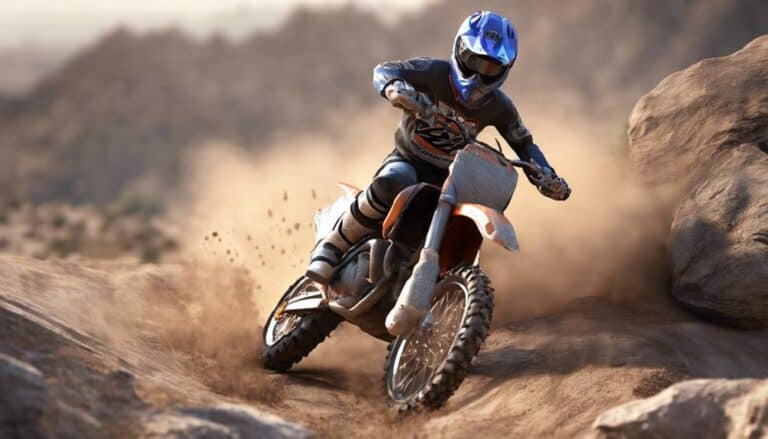Imagine yourself cruising through diverse terrains on a dirt bike, each presenting unique challenges and obstacles. As you tackle flat, uphill, downhill, sandy, and rocky surfaces, your body positioning becomes an important element in maneuvering with finesse and control.
The way you shift your weight, adjust your stance, and anticipate the terrain ahead can make all the difference in how smoothly you glide through each landscape. But how exactly does body positioning impact your ability to conquer these terrains effectively?
Stay tuned to uncover the intricate dance between rider and bike that guarantees a harmonious journey through varying landscapes.
Key Takeaways
- Proper body positioning enhances stability and control on flat, uphill, downhill, sandy, and rocky terrains.
- Adjusting weight distribution optimizes maneuverability and traction on various types of terrain.
- Leaning forward or back depending on the terrain type improves stability and prevents accidents.
- Body positioning directly impacts confidence, handling, and overall performance while navigating diverse terrains on a dirt bike.
Body Positioning on Flat Terrain
When riding on flat terrain with your dirt bike, maintaining balance over the pivot point is crucial for achieving stability and control. Your body positioning plays a pivotal role in keeping the bike steady and responsive. Positioning your chin over the handlebars helps in controlling the bike's direction and enhances stability. Confirm your elbows are bent upward and outward to maintain the correct posture for maneuverability. By centering your body over the bike's pivot point on flat terrain, you enhance overall stability and control while riding.
Proper body positioning on flat terrain enables you to make quick adjustments and handle the bike more smoothly. It allows you to react swiftly to changes in the terrain and maintain control over the bike. Remember, on flat terrain, your body acts as the key to maintaining balance and ensuring stability. By following these guidelines for body positioning, you can navigate flat terrain with confidence and precision, optimizing your dirt bike riding experience.
Body Positioning on Uphill Terrain
Body positioning on uphill terrain requires a forward lean to stabilize the front wheel and prevent tipping backward. Leaning forward helps keep the front wheel grounded, providing traction and control, especially on steep inclines. By shifting your weight towards the front of the bike, you improve stability and prevent the bike from flipping over. Distributing your weight effectively by leaning slightly back can further enhance stability on uphill terrain. This adjustment in body positioning not only aids in maintaining traction but also prevents stalling, ensuring a smoother ride. Correct techniques on uphill terrain not only boost your confidence but also elevate your overall performance by keeping the bike balanced and your control optimized.
| Uphill Terrain Body Positioning | |
|---|---|
| Leaning Forward | Stabilizes Front Wheel |
| Shifting Weight | Improves Traction |
| Distribute Weight | Enhances Stability |
| Grounded Front Wheel | Prevents Tipping |
| Control and Stability | Maintains Rider Confidence |
Body Positioning on Downhill Terrain
Leaning back slightly on downhill terrain is important to maintaining balance and control while maneuvering challenging slopes. Proper body positioning on downhill terrain is vital for a smooth descent.
Here are three key elements to ponder:
- Keeping Weight Centered: Make sure your weight stays over the bike to prevent tipping forward on downhill slopes.
- Bending Knees and Elbows: Absorb impacts and vibrations by bending your knees and elbows, allowing for better control.
- Adjusting Body Position: Optimizing traction and stability involves adjusting your body position to match the changing terrain, enhancing control and confidence.
Body Positioning on Sandy Terrain
To navigate sandy terrain effectively on a dirt bike, adjusting your weight slightly backward is essential for maintaining balance and stability. Shifting your weight back helps prevent the front wheel from digging into the sand, keeping the bike upright and stable.
Utilize your legs for support and balance, allowing you to maneuver through the sandy terrain with greater control. By maintaining a relaxed grip on the handlebars, you enable the bike to move smoothly over the shifting surface without losing traction.
It's important to adjust your body position continuously to adapt to the changing conditions of sandy terrain, ensuring best control over the bike. Flexibility in your body positioning allows you to respond dynamically to the challenges posed by sandy terrain, enhancing your overall riding experience.
Body Positioning on Rocky Terrain
Traversing rocky terrain demands a well-distributed weight to secure superior maneuverability and control on your dirt bike. To navigate rocky terrain effectively, it's important to adjust your body positioning accordingly. Here are key techniques to optimize your performance on rocky surfaces:
- Shift Your Weight Back: Keeping your weight towards the rear of the bike helps in lightening the front wheel, enhancing maneuverability over rocky obstacles.
- Standing on the Footpegs: Standing up on the footpegs allows your legs to act as natural shock absorbers, minimizing the impact of vibrations and bumps encountered on rocky terrain.
- Leaning Forward: Leaning slightly forward while riding on rocky surfaces improves traction and stability by ensuring the front wheel maintains contact with the ground, enhancing control and overall handling.
Conclusion
To sum up, proper body positioning is vital for traversing through different terrains on a dirt bike.
For instance, consider a rider tackling a rocky terrain. By leaning back slightly, gripping the bike with their knees, and keeping their weight centered, the rider can maintain control and stability over the rough and uneven surface.
Mastering body positioning techniques is key to conquering various terrains with confidence and skill.

